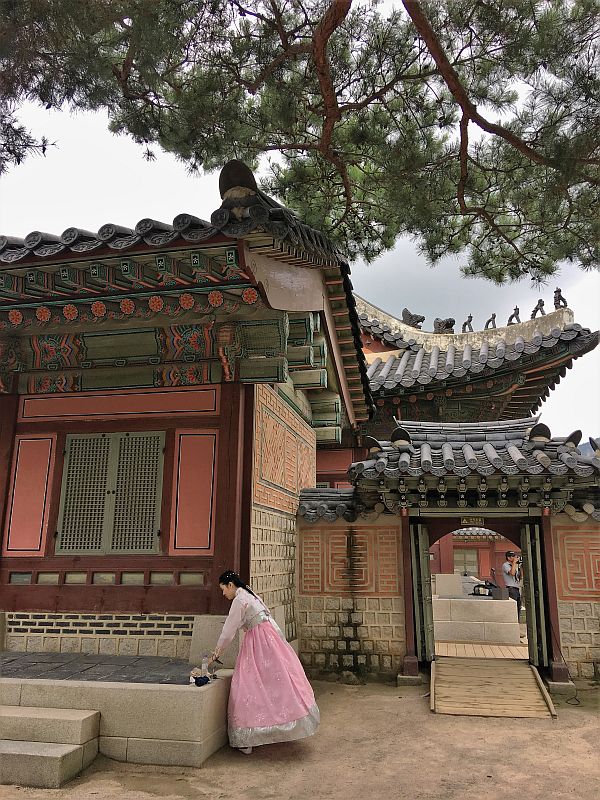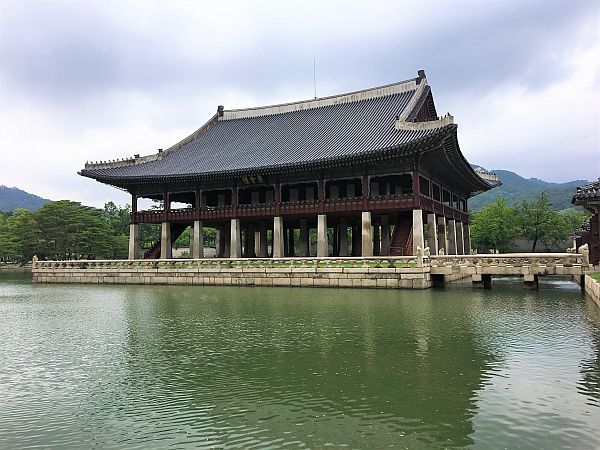AIR YOU GO TRAVELS’ ‘SEOULFUL KOREA’

It’s not rare to see tourists and locals alike wearing hanbok (Korean traditional dress) inside Gyeongbok Palace. It’s as if you’ve been transported to the Joseon Dynasty centuries ago.
JUST like any travel destination, South Korea, otherwise known as the Land of the Morning Calm, has several spots one must not miss.
Its capital city, Seoul, boasts a distinct juxtaposition of the old and the new. Here, it is not surprising to see palaces in between skyscrapers or Korean traditional houses, also known as “hanok,” beside towering condominiums.
Time-traveling from the present to centuries back can be as easy as a five-minute walk or a short subway ride. But always be ready to get lost or mixed up with all the different exits.
After all, what good is an adventure without getting a little astray and having to ask locals for directions?
GYEONGBOKGUNG
The largest and grandest of Seoul’s five palaces built by the Joseon Dynasty is Gyeongbokgung or Gyeongbok Palace.
It was built in 1395, burned to the ground in 1592 during the Japanese invasion, and later on reconstructed in 1867. The 40-hectare property is home to different halls and rooms intended for certain activities—a pavilion for banquet dedicated to foreign envoys and other guests, a hall where the king and his ranking officials meet, and an open area where the king made declarations of national importance, to name a few.
One or two hours won’t be enough to explore the entire palace so it’s advisable to check out the main buildings like the king’s quarters and the throne hall for banquets, nestled in an artificial island surrounded by a man-made lake.
But these spots are overflowing with tourists eagerly taking photos and selfies. This is why you could also opt to tread the less visited alleys for a little quiet time to appreciate the buildings’ intricate designs.
To make it a full experience, one can rent a hanbok (Korean traditional costume) outside the palace and walk around as if you’re back in the Joseon Dynasty.
Hanbok rental typically costs 10,000 won or around P450 to P500 for an hour of use. If you wear a hanbok inside the palace, you won’t have to pay the entrance fee. Sweet!

A view of the Gyeongbok Palace’s gate
NAMSAN TOWER
Another iconic landmark in Seoul is the Namsan Seoul Tower. Apart from being an actual tower broadcasting signals for Korean broadcasting stations, N Seoul Tower is also a magnet for tourists with its observatory and tower plaza which is home to thousands of “love locks” left by couples who visit the romantic site to express their unending love.
If you’re a K-Drama fan, you have probably seen this place several times.
This was where Heo Joon-jae, Lee Min-ho’s character in the drama “Legend of the Blue Sea,” waited for Shim-cheong (played by Jun Ji-hyun) when the first snow came.
The tower was also a common backdrop during scenes at Heo Joon-jae’s house which is actually just at the foot of the Namsan Mountain where the tower sits atop.
It’s a perfect vantage point in the daytime where you get a complete 360-degree panoramic view of Seoul City as the tower itself is 237 meters high.
At night, the view transforms into a sea of city lights, perfect for dates or bonding with friends. There are cafes, restaurants and convenience stores, too!
But there’s always a price to pay for such magnificent view. Prepare your most comfy pair of shoes as you’ll have to take a five-minute climb up a steep road from the parking area where buses and other vehicles are allowed at the foot of the tower.
One can also opt to take a cable car ride from the foot of the mountain all the way to the tower’s plaza.
KIMCHI AND GINSENG
When you talk about Korea, you can’t miss kimchi. This cabbage-based side-dish is Korea’s representative food and is essential in every Korean meal.
Whichever restaurant you go, there’s always kimchi. It is made by salting cabbage and adding red-pepper powder, garlic, onions, ginger, radish and grated apple as a natural sweetener. One can experience making this dish in one of Seoul’s many kimchi making academies for less than 30 minutes.
Our instructor, Lily, a Filipina, said kimchi was first discovered by Koreans 3,000 years ago. These were placed in stone jars and buried underground by October before winter comes. Households would usually do this for whole year’s supply of kimchi whose shelf life is three years. Korea also has its representative medicinal crop—ginseng. This “miraculous medicine” is a popular traditional medicine among Koreans and comes in a variety of forms—capsules, teas, food additives, among others. It is widely used in the olden days as a natural way to strengthen one’s body and recover their health.
The highest quality ginseng can cost thousands of dollars and are commonly offered by the Korean government as tokens to visiting high-ranking officials like presidents from other countries.
SIDE TRIPS AND GETTING LOST
There is so much to discover in the enchanting city of Seoul. A few days is guaranteed inadequate to fully experience all of what Seoul can offer.
Air You Go Travel’s four-day Seoulful Korea tour is jam-packed with exciting activities that make you experience the most out of a short visit.
From Nami Island, Petite France, Mt. Seorak, which we featured last week, to the ones aforementioned, it is already a full schedule. But no matter how tired you may be, there’s always room for side trips in Seoul, especially at night.
Although majority of “ahjummas” and “ahjussis” (Korean term for middle-aged women and men) may not be able to speak straight English with you, they will still try hard to help.
As our tour guide, Angie suggested, it’s better to speak with locals using basic English keywords instead of long sentences.
A simple “Where is exit to Gwanghwamun Square?” is much better than saying “Where do we go to get to Gwanghwamun Square from here?” Or better yet, approach the younger Koreans who are noticeably always on their phones especially in subways.
If you get your question across, they can quickly help you search which bus number or subway line to take to get to your destination.
Just say a quick “kamsahamnida” (thank you) after they lend a hand.
Raining hard or not, we did not waste our extra time in Seoul by dozing off in hotel rooms.
Instead, we ventured into our own mini-adventures including shopping and enjoying street food.
Myeongdong is a perfect haven for both. It is a maze of high-end brands to homegrown Korean brands.
But Myeongdong is most popular for housing all Korean cosmetic brands that never run out of sales and promos. You can get a free face mask by just visiting a shop.
Visit enough and you won’t have to even buy! In between alleys is a smorgasbord of stalls that sell all kinds of street food—smoked lobster, fresh fruits, steaks, corn dogs, egg bread, tteokbokki or korean spicy rice cakes, dakgangjeong or boneless sweet and spicy chicken bites, to name just a few.
You also can’t miss out on soju, beer and chicken—a classic combo. Getting around these places could be a bit tricky. But with the help of Seoul’s subway app, pocket wifi connection, and a little asking around, we managed to go from out hotel to nearby spots like Myeongdong and Dongdaemun which is home shopping malls that open until 3 a.m. as well tents of street food.
Seoul’s subway is clean, safe and efficient. It was still an experience for the books even if we only passed through two or four stations. Whichever type of traveler you are—the nature-tripper, shopaholic, history geek, foodie, or a regular tourist—Seoul definitely has something to offer.
This wonderful city is melting pot of history, culture, cuisine, and technological advancements. One trip would never be enough to satisfy one’s “Seoul” searching.
Good thing Korea is just a four-hour flight away from Cebu and is easily accessible by Cebuanos as there is already a Korean Consulate in Cebu City where one can apply for a tourist visa.
Even for someone who’s been to the land of K-Drama, K-Pop and Kimchi for three times already, there is still always something more that Korea can offer.
After all, Korea is where seasons are four and skin care products are to die for!


